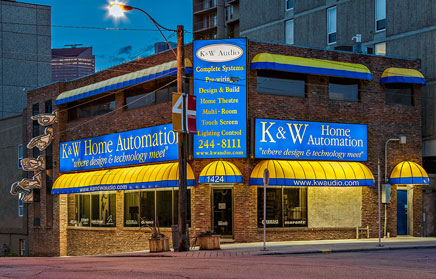TIP# 34:
During this time of high growth in the building industry, coupled with the popularity of home renovations, we are often consulted regarding pre-wiring or re-wiring a home for audio. We thought you might find the following helpful in planning the infrastructure for your dream system’s operation.
We recognize that every house, budget, and performance criteria are different. That’s where we come in, so feel free to come see us with your plans, our experience and friendly advice is yours for the asking. If you like all your fingers their stock size and would prefer to leave the installation to a professional, we have the best in the business. We can also offer you a wide range of options, from do it yourself to go on vacation and come back to a system that actually works! That said, here are some helpful hints on doing the best possible job for the least amount of hassle.
One can expect a quality multi-room system to give wonderful music throughout your home, but the first rule of thumb is proper planning. The next step is to decide on the primary listening room, as this is normally where the system’s components are located. Determine the audio sources (AM/FM, CD, Tape, DVD, DSS Audio etc.), as these are the components we will need, then decide where in the room these components fit best. Having taken care of where the system is to be situated, we can now turn our attention to the wiring for distribution of sound to the kitchen, bedroom, games room, patio etc., terminating with the type of speakers designed for the acoustic environment they are to serve.
The world’s finest multi-room systems are actually the easiest to wire as they tend to use their own specific cables, usually enclosed in only one jacket which is then run from the main system to each location where music is desired. Bang & Olufsen is considered the best in this regard since they invented the concept. So, in our first example lets use their Beo-link system.
Assume that in the main room we have decided on an AM/FM radio with a CD Player for our musical needs. It would be nice to be brought into the new day with a favorite CD in the morning, hear the morning news in the kitchen to be followed by music. That’s all the information we need to do the wiring.
In this case, we would simply pull one B&O Power-link wire from the main system to just above the headboard in the bedroom, and another to the most suitable location in the kitchen (taking the acoustical environment into consideration). Since B&O have specific auxiliary room units, which combine speakers, amplifiers and remote control sensors, a power outlet close to the wire’s location is the only other pre-wiring requirement. That’s it, you’re done!
Hey, that was so simple, so why not make sure that you aren’t leaving out a room that you may want to add to your system sometime down the road, the office or the workout station for example. If you are in the pre-construction stage, the cost of cable is minimal, and the value is always in the house, even if you decide to sell the house before exploiting the system’s full potential.
But, what if Bang and Olufsen is not in your future? Lets assume that you have a remote controlled receiver with a CD player and tape deck, and you would like music in the living room too, and want to try to make sure that you won’t kick yourself later for making a wrong decision.
No problem here, as we have a variety of infrared(IR) repeater systems available which can operate over 90% of the equipment on the market. The main thing is making sure that we pre-wire correctly to allow for flexibility in selecting auxiliary components later on. We have a number of horror stories we can tell you about, so be cautious!
Again we make our decisions based on where the main system is located. However, in this situation we will wire with a number of different cables AND use a different path. The most important rule when pre-wiring for this type of situation is NOT to run the speaker cable from the main system, directly to the loudspeaker locations. If this is done, it can be very costly to add separate volume and IR control capability later.
Start by pulling two pairs of speaker cables, along with a minimum three conductor shielded data cable, to a convenient switch height location in the living room. We usually use a metal type in wall switch box, or J Box. From that box, speaker cable is run to each of the speaker locations. If you are undecided about whether to use “in ceiling” or “in wall” or floor standing speakers, we suggest that you run the cable over the ceiling and down the wall to the floor, make note of their location somewhere where you won’t lose it.
Now the wiring is complete, this is how we can use it. Let’s suppose you would like to use that old pair of speakers left over from your college days in the living room. Simply reach into the J box in the wall and connect the speaker cables coming from the stereo to the ones running to the new speaker locations. Pop off the baseboard, pull out the cable in the wall, and hook up those old monsters. Done!
But what if they play quite loud, compared to the speakers in the main room. No problem, purchase an “in wall” volume control, attach it to the speaker cables coming in and out of the J box. Result, independent sound control. This was the reason for running two pairs of speaker wires to the one location first. But wait, it would be nice to switch from the CD player to the radio, to catch the news. Again no problem, just purchase an infrared repeater system and connect it to the data cable running the IR Sensor in the living room. We can now control the volume and use the system’s remote control to give us the flexibility to switch from CD to tape, move forward on CD to a better song, etc. That’s why we pulled a data wire.
Finally, perhaps you would prefer a keypad that did everything your volume control and remote can do. Something discretely mounted on the wall would be more convenient, (no more lost remotes) and a more elegant look. Perhaps a set of “in ceiling” loudspeakers would not only be less obtrusive but would sound a lot better than a pair of speakers built in the seventies. Simply replace the volume control and IR eye with a decorator multifunction keypad, in your preferred decorator color. Purchase your “in ceiling” loudspeakers and install, using the supplied templates to cut the holes in the ceiling, over the location of the speaker cables (previously noted, right) install the speakers and relegate those old towers to the garage…again.
The main thing to remember with any multi-room system, is that wire is cheap. If you are going to do a job, why not do it right, and give yourself peace of mind, knowing that you have prepared correctly for hassle free music throughout your home. Happy listening!


